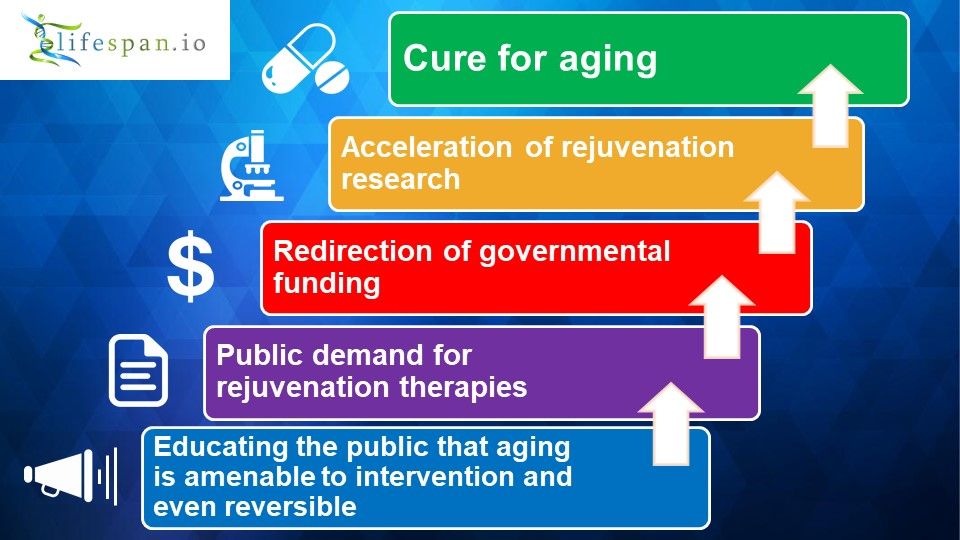Eat This, Not That! –Bioquark Inc.


Good information 💜.
Dr. Antonei Csoka of Howard University discusses the concept of aging as meta-disease and about the hierarchy of some of the Hallmarks of Aging. He also discusses some of the philosophical and metaphysical underpinnings for the goal of overcoming age-related disease.
►Conference Page: https://www.leafscience.org/ending-age-related-diseases-adva…prospects/
►Subscribe for more: https://www.youtube.com/user/LifespanIO?sub_confirmation=1
►This video is presented by LEAF. Please support our work by becoming a “Lifespan Hero”: http://lifespan.io/hero
The October Journal Club will be focusing on a new study in worms where a combination of compounds acted in synergy to almost double lifespan.
SUMMARY There is growing interest in pharmacological interventions directly targeting the aging process. Pharmacological interventions against aging should be efficacious when started in adults and, ideally, repurpose existing drugs. We show that dramatic lifespan extension can be achieved by targeting multiple, evolutionarily conserved aging pathways and mechanisms using drug combinations. Using this approach in C. elegans, we were able to slow aging and significantly extend healthy lifespan. To identify the mechanism of these drug synergies, we applied transcriptomics and lipidomics analysis. We found that drug interactions involved the TGF-b pathway and recruited genes related with IGF signaling. daf-2, daf-7, and sbp-1 interact upstream of changes in lipid metabolism, resulting in increased monounsaturated fatty acid content and this is required for healthy lifespan extension. These data suggest that combinations of drugs targeting distinct subsets of the aging gene regulatory network can be leveraged to cause synergistic lifespan benefits.

Imagine a digital avatar of ourselves living on after we die. They could help comfort our loved ones, and they could also preserve expertise and experience. There’s some benefits, but it’s still questionable if this is comforting, or just creepy.
A digital afterlife may soon be within reach, but it might not be for your benefit.
The reams of data we’re creating could soon make it possible to create digital avatars that live on after we die, aimed at comforting our loved ones or sharing our experience with future generations.
That may seem like a disappointing downgrade from the vision promised by the more optimistic futurists, where we upload our consciousness to the cloud and live forever in machines. But it might be a realistic possibility in the not-too-distant future—and the first steps have already been taken.


Today we have the transcript of “Pursuing Outreach Opportunities: Lifespan.io’s Experiences in Promoting Healthy Life Extension”, a talk that LEAF Outreach Director Elena Milova gave at TransVision 2018, a transhumanist conference in Madrid, Spain recently.
This is the transcript of “Pursuing Outreach Opportunities: Lifespan.io’s Experiences in Promoting Healthy Life Extension”, a talk that LEAF Outreach Director Elena Milova gave at TransVision 2018, a transhumanist conference in Madrid, Spain.
My name is Elena Milova, and I work with the Life Extension Advocacy Foundation, a non-profit organization headquartered in New York City. Our main activity is to support research on regenerative therapies that can possibly make human life healthier and longer. To do that, we have developed the non-profit crowdfunding platform Lifespan.io, and, as of now, we have gathered more than 300 thousand dollars in support of 7 scientific projects. We are currently running a campaign to support David Sinclair’s NAD+ Mouse project, a study of NMN and its effect on healthy lifespan in mice.
Another direction of our activity is to educate the public about the potential of rejuvenation therapies.

Protein RbAp48 works with osteocalcin to preserve memory in old age.
In a recent open-access study, scientists at Columbia University have demonstrated that a protein known as RbAp48 crucially interacts with osteocalcin to help preserve memory. The protein, which is present in mice as well as people, declines with age, contributing to age-related memory loss [1].
Abstract
Precisely deciphering the molecular mechanisms of age-related memory loss is crucial to create appropriate therapeutic interventions. We have previously shown that the histone-binding protein RbAp48/Rbbp4 is a molecular determinant of Age-Related Memory Loss. By exploring how this protein regulates the genomic landscape of the hippocampal circuit, we find that RbAp48 controls the expression of BDNF and GPR158 proteins, both critical components of osteocalcin (OCN) signaling in the mouse hippocampus. We show that inhibition of RbAp48 in the hippocampal formation inhibits OCN’s beneficial functions in cognition and causes deficits in discrimination memory. In turn, disruption of OCN/GPR158 signaling leads to the downregulation of RbAp48 protein, mimicking the discrimination memory deficits observed in the aged hippocampus. We also show that activation of the OCN/GPR158 pathway increases the expression of RbAp48 in the aged dentate gyrus and rescues age-related memory loss.

In this interview, Vera Gorbunova, Professor of Biology at the University of Rochester and a co-director of the Rochester Aging Research Center, talks about our current understanding of the mechanisms behind the longevity and genome stability of exceptionally long-lived mammals and how this knowledge could be used to create therapies to extend healthy human lifespan.
The interview was made by Steve Hill and Elena Milova, members of the board of Lifespan.io.
►This video is presented by LEAF. Please support us by becoming a “Lifespan Hero”: http://lifespan.io/hero

It seems that opposition against anti-aging medicine may be slowly starting to crumble. For example, Lifespan.io’s current crowdfunding campaign is going extremely well, and journalists begin to talk about senolytics in positive terms, without any predictions of doom and gloom resulting from these upcoming drugs. Make no mistake—the pro-aging trance is still alive and well; for each journalist who puts time and effort into actually understanding senolytics and the health benefits that they are expected to bring to older people, there’s probably five who show little to no knowledge of the subject and rage against unspecified “immortality” technology and related impending catastrophes. This should tell us something about the kind of understanding they have of what they criticize—or how badly they need a clickbait piece to bring in visitors.
Today, the pro-aging trance is something that only rejuvenation advocates are aware of and battle against, but maybe, fifty years from now, it will be an interesting phenomenon of the past for psychologists to figure out. Maybe, on the YouTube of 2068, there will be videos making fun of it in pretty much the same way that some people today make fun of the old belief that hysteria was caused by stray uteruses wandering around women’s bodies.
The pro-aging trance is rather interesting indeed, as people who are subject to it tend to commit fallacies that they would never commit in other contexts. A very good example of this is the objection to inequality of access: this reasoning assumes that rejuvenation would not be available to everyone who needs it, for economical, political, or whatever reasons; understandably, this is perceived as a profound injustice, which pushes a fair number of people to make a leap and conclude that the best way to avoid this injustice is to never develop rejuvenation to begin with.